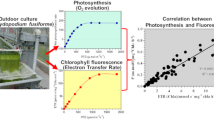Abstract.
Sulfur deprivation in green algae causes reversible inhibition of photosynthetic activity. In the absence of S, rates of photosynthetic O2 evolution drop below those of O2 consumption by respiration. As a consequence, sealed cultures of the green alga Chlamydomonas reinhardtii become anaerobic in the light, induce the "Fe-hydrogenase" pathway of electron transport and photosynthetically produce H2 gas. In the course of such H2-gas production cells consume substantial amounts of internal starch and protein. Such catabolic reactions may sustain, directly or indirectly, the H2-production process. Profile analysis of selected photosynthetic proteins showed a precipitous decline in the amount of ribulose-1,5-bisphosphate carboxylase-oxygenase (Rubisco) as a function of time in S deprivation, a more gradual decline in the level of photosystem (PS) II and PSI proteins, and a change in the composition of the PSII light-harvesting complex (LHC-II). An increase in the level of the enzyme Fe-hydrogenase was noted during the initial stages of S deprivation (0–72 h) followed by a decline in the level of this enzyme during longer (t>72 h) S-deprivation times. Microscopic observations showed distinct morphological changes in C. reinhardtii during S deprivation and H2 production. Ellipsoid-shaped cells (normal photosynthesis) gave way to larger and spherical cell shapes in the initial stages of S deprivation and H2 production, followed by cell mass reductions after longer S-deprivation and H2-production times. It is suggested that, under S-deprivation conditions, electrons derived from a residual PSII H2O-oxidation activity feed into the hydrogenase pathway, thereby contributing to the H2-production process in Chlamydomonas reinhardtii. Interplay between oxygenic photosynthesis, mitochondrial respiration, catabolism of endogenous substrate, and electron transport via the hydrogenase pathway is essential for this light-mediated H2-production process.
Similar content being viewed by others
Author information
Authors and Affiliations
Additional information
Electronic Publication
Rights and permissions
About this article
Cite this article
Zhang, L., Happe, T. & Melis, A. Biochemical and morphological characterization of sulfur-deprived and H2-producing Chlamydomonas reinhardtii (green alga). Planta 214, 552–561 (2002). https://doi.org/10.1007/s004250100660
Received:
Accepted:
Issue Date:
DOI: https://doi.org/10.1007/s004250100660




